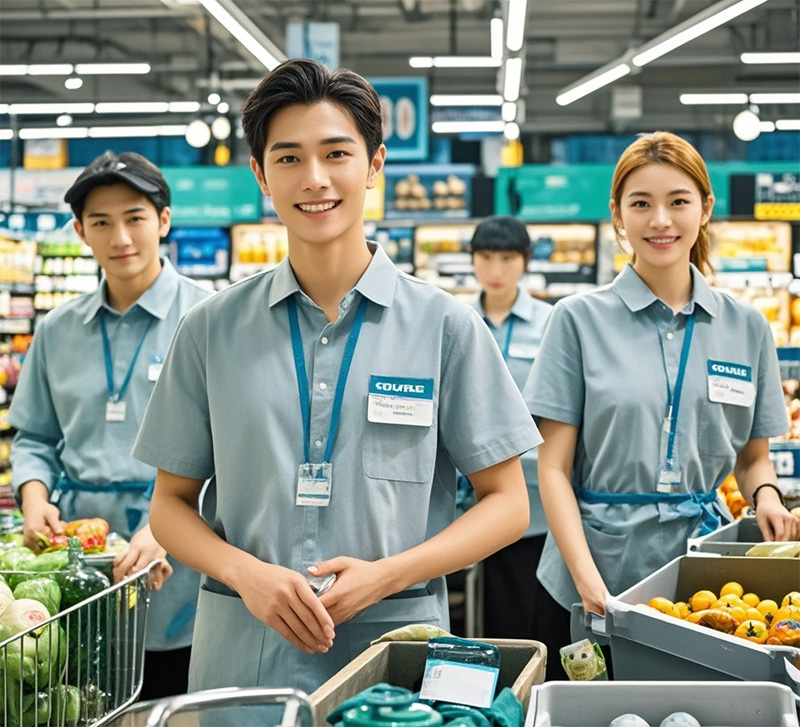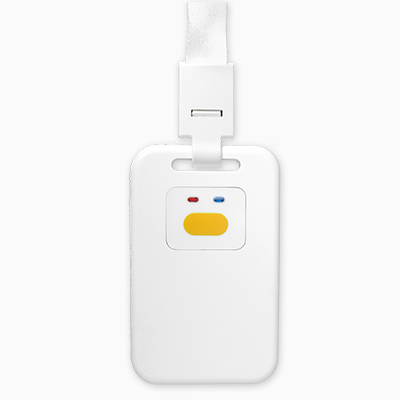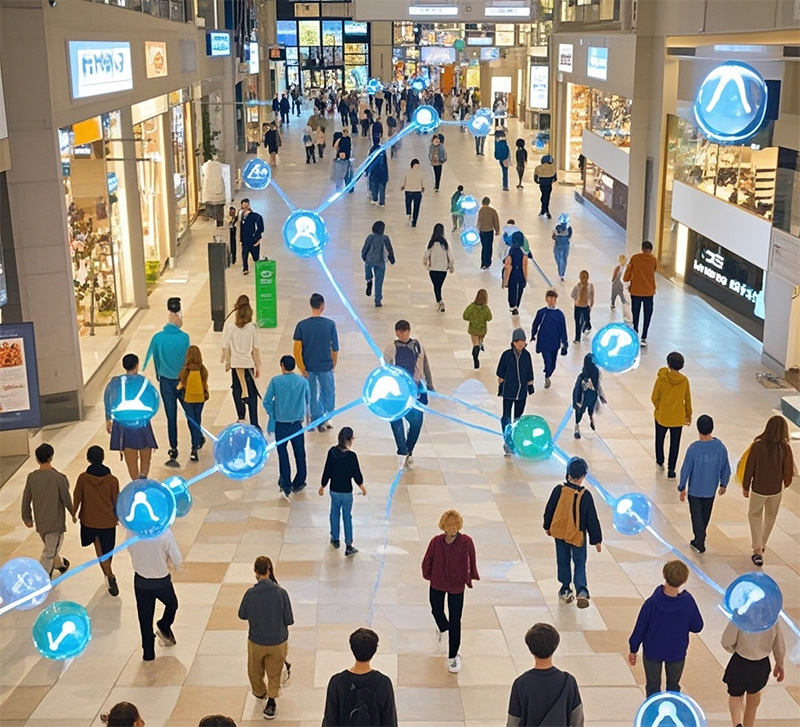In supermarkets and shopping centers, personnel positioning has many applications, whether based on UWB or Bluetooth technology. In supermarkets, UWB technology can accurately locate employees to improve management and work efficiency, prevent theft, and provide personalized shopping guidance and location-based promotional push for customers; Bluetooth technology can be used for employee area positioning and task allocation, attendance and work hour statistics, and can also assist customers in indoor navigation and behavior analysis to improve services. In shopping centers, UWB technology helps with precise monitoring of personnel flow, emergency response, optimization of facility layout, and can also provide customers with accurate navigation, car search, and personalized recommendations; Bluetooth technology can be used for indoor navigation, area information push, member check-in points, and promoting social interaction.
1、 Personnel positioning application in supermarkets

(1) Based on UWB technology
Accurately locate employee positions: In large supermarkets, employees are distributed in various areas such as shelf areas, warehouses, cash registers, etc. UWB technology can achieve centimeter level high-precision positioning, and supermarket managers can accurately view the real-time location of each employee through the monitoring system. For example, when a customer needs help in the fresh food area, the manager can quickly locate nearby employees and notify them to provide services, greatly improving the timeliness of the service.

Optimize workflow and path planning: The UWB positioning system can record the movement trajectory of employees inside the supermarket. By analyzing these trajectories, managers can identify efficiency bottlenecks for employees in their workflow. For example, if it is found that the replenishment staff's walking route between shelves is circuitous or unnecessary, the replenishment process can be optimized to reduce ineffective walking of employees and improve work efficiency.
Preventing employee theft: By accurately locating employees, if they stay in non work areas (such as valuable items storage areas in warehouses) for too long or have abnormal movement paths (frequent entry and exit restricted areas), the system can issue an alarm, which helps prevent internal theft by employees and ensure the safety of supermarket property.
Personalized shopping guidance: When customers enter the supermarket, they can choose to activate the UWB technology-based supermarket navigation application on their mobile phones. After the customer inputs the list of products they want to purchase, the system will plan the best shopping route based on the customer's real-time location, guiding the customer to quickly find the products. For example, for customers who purchase baby products, the system can prioritize guiding them to the mother and baby area, reducing their search time in the supermarket and improving their shopping experience.
Location based promotion push: UWB positioning system can identify customers' stay areas within the supermarket. If customers stay in a promotional area (such as a beverage promotion pile) for a long time, supermarkets can promptly push relevant promotional information to customers' mobile phones, such as matching packages and discount coupons for the beverage, to stimulate customers' purchases and increase sales.
(2) Based on Bluetooth technology
Regional positioning and task allocation: Although Bluetooth positioning technology has lower accuracy compared to UWB, it can still meet basic positioning needs in supermarket environments. Supermarkets can divide the entire area into different Bluetooth signal coverage areas, such as food areas, daily necessities areas, etc. Managers can allocate work tasks reasonably by checking the Bluetooth area where employees are located. For example, assigning cleaning tasks in the food area to cleaning staff near the area can improve the rationality of task allocation.

Employee attendance and work hour statistics: Bluetooth beacons are set up at the entrance of the supermarket and various work areas. When employees enter the work area, their Bluetooth devices (such as work cards) are connected to the beacons, and the system automatically records the employee's attendance time. At the same time, based on the duration of employees' stay in different areas, it is possible to accurately calculate their working hours and facilitate salary settlement.
Indoor navigation assistance: After entering the supermarket, customers can use the Bluetooth function on their mobile phones to achieve basic indoor navigation. Supermarkets set up Bluetooth beacons at key locations (such as passage intersections, elevator entrances, etc.), and customers' mobile applications provide navigation guidance based on the received Bluetooth signal strength and direction information. Although the accuracy is not as good as UWB, it is sufficient to help customers find the main product areas, such as fresh food areas, frozen food areas, etc.
Customer behavior analysis and service improvement: By analyzing the data generated by the interaction between customers' mobile phones and Bluetooth beacons, supermarkets can understand customers' flow patterns and stay in hotspot areas. For example, if many customers are found to stay in front of a certain shelf for a short period of time before leaving, it may indicate that there are problems with the product display or variety in that area. Supermarkets can adjust accordingly to better meet customer needs.
2、 Personnel positioning application in shopping centers

(1) Based on UWB technology
Accurate personnel flow monitoring: In large places like shopping centers, UWB technology can accurately count the personnel flow in various areas (such as different floors, surrounding stores, etc.). Managers take advance safety precautions in densely populated areas (such as food courts during peak dining hours) based on real-time personnel flow data, such as increasing security personnel and optimizing evacuation routes, to ensure the safety of personnel.
Emergency response: In the event of an emergency (such as a fire, earthquake, etc.), the UWB positioning system can quickly determine the precise location of each person within the shopping center. Rescue personnel can prioritize rescuing people trapped in dangerous areas based on location information, improving the efficiency of emergency rescue.
Facility and store layout optimization: By collecting long-term UWB positioning data from customers, analyze their activity trajectories and stay time distribution within the shopping center. If it is found that the customer flow in a certain area is low, but the area has a large store area, the mall manager can consider adjusting the store layout, relocating popular stores to the area or changing the business format of the area (such as changing from retail to leisure and entertainment), in order to improve the operational efficiency of the entire shopping center.
Accurate navigation and car search services: For large shopping centers, customers often face the problem of not being able to find their store or parking location for their vehicles. UWB technology can provide customers with precise indoor navigation services, from the moment they enter the shopping center until they find the target store or vehicle in the parking lot. For example, when customers enter the name of the restaurant they want to go to on their mobile phones, the system will guide them to the most convenient route to reach their destination. Along the way, it can also display information about shops along the way, increasing customers' consumption opportunities.
Location based personalized recommendation: When customers walk around the shopping center, the UWB positioning system can track their location in real time. Based on customers' location information and their past consumption records and preferences, shopping centers can push personalized recommendation information to customers' mobile phones. For example, when a customer approaches a cinema, if the customer has a previous viewing history, the system can recommend movies that are currently showing and match the customer's preferences, and provide ticket discount information.
(2) Based on Bluetooth technology
Basic indoor navigation: Set up multiple Bluetooth beacons in the shopping center, and customers can interact with the beacons using the Bluetooth function on their mobile phones to achieve basic indoor navigation. Although the accuracy is limited, it is sufficient to guide customers to the main areas of the mall, such as flagship stores and public facilities (toilets, elevators, etc.). For example, when customers enter from the mall entrance, the Bluetooth navigation system can prompt them on how to get to the nearest elevator and reach the target floor.
Region based information push: The Bluetooth positioning system can push relevant information to customers based on their Bluetooth region. For example, when a customer enters a brand collection area, the system can push information about ongoing promotional activities, newly arrived products, etc. in that area to attract customers' attention and increase their likelihood of consumption.
Member check-in and point rewards: For members of shopping centers, they can check-in at specific check-in points within the mall (such as Bluetooth beacons near the member service center) through their mobile Bluetooth. After successful check-in, they can receive rewards such as points or coupons. This can not only increase the activity of members, but also encourage them to consume more in the mall.
Social interaction promotion: Bluetooth technology can be used to build social networks within shopping centers. For example, customers can choose to enable Bluetooth based social functions. When they approach other customers with similar interests (matched through membership information or consumption preferences) in the mall, the system can prompt both parties, promote social interaction between customers, and increase their stay time and consumption opportunities in the shopping center.
Prev:The advantages of UWB precise positioning in high-speed communication
Next:Mine personnel vehicle positioning system: guarantee of safety and efficiency
Copyrights© Shenzhen Skylab Co.,LTD All Rights Reserved.

